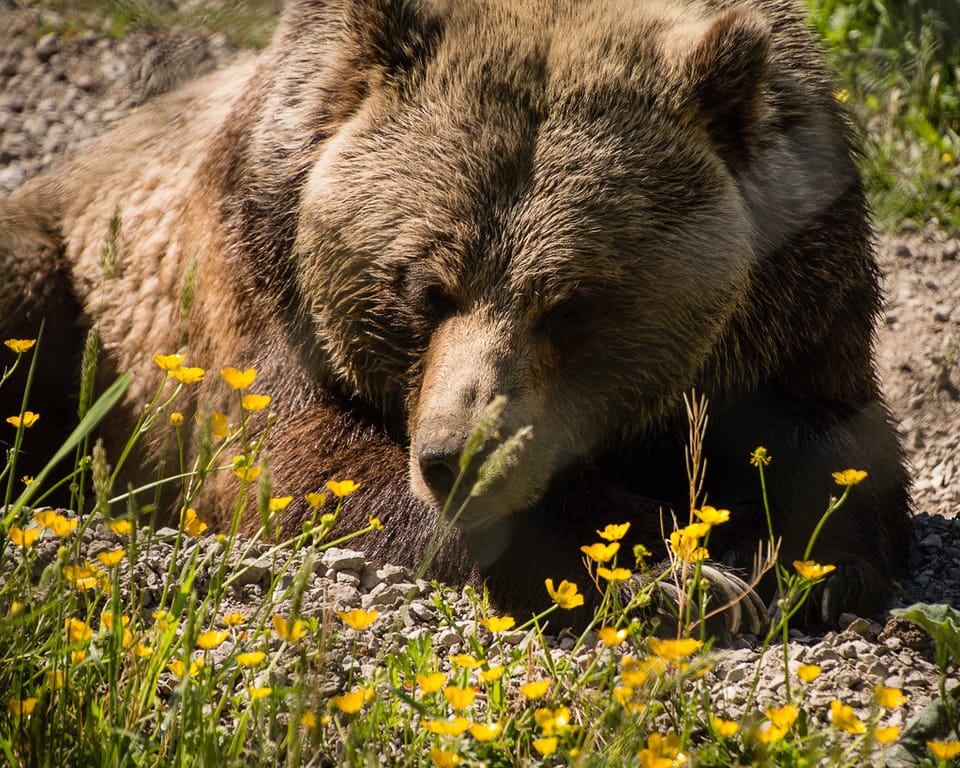Carnivores and Communities in Southern Alberta

“Our family has ranched south of Cardston and east of Highway 2 since 1917,” says Jeff Bectell, Director and Carnivores and Communities Program Coordinator, Waterton Biosphere Reserve. “The first time we saw a grizzly bear was in 1993 and the first livestock kill was around 1995-98.” Historically, the grizzly bear’s range extended from Manitoba to British Columbia. Their numbers have gone down significantly and are no longer common on the Prairies. In 2010, grizzly bears were classified as threatened by the Government of Alberta due to population size, human-caused mortality rates, and questionable habitat quality. At that time, there were 700-800 bears in the province. Since that time the grizzly bear population has been increasing with 856 to 973 grizzly bears reported in Alberta in 2021. (Black bear numbers are much higher and they are not considered to be at risk.)
Community reaction to the grizzly bear receiving protection status was mixed. People living near the Rockies were used to having bears on their property, while it was an emerging problem further east. Individual landowners and communities were seeking solutions throughout southwest Alberta, and the Government of Alberta was able to provide support for some of these initiatives. In 2010, following a public meeting in Cardston, the provincial government provided $10,000. These funds were combined with additional funding from the Waterton Biosphere Reserve Association (WBRA) to help landowners decrease conflict with bears, wolves, and cougars. Initial funding was used to remove dead livestock that serve as a major attractant to grizzly bears.
The Waterton Biosphere Reserve began managing a larger provincial grant the following year, formalizing the WBRA’s Carnivores and Communities Program (CACP) within a defined geographic area stretching from Chain Lakes to the Montana border. Both the biosphere reserve and the CACP are community-based. The CACP is informed by the Carnivore Working Group (CWG) made up of local livestock owners, land managers, biologists, municipal representatives, and others. The CWG agrees that grizzly bears (along with other large carnivores such as wolves and black bears) have a place on the landscape, but this can lead to conflict. They support a multi-pronged response incorporating on-farm mitigation practices (which decrease large carnivore attractants), compensation for livestock losses due to predation by large carnivores, and management of large carnivores (including lethal control when necessary).
Attractant Management
Attractant management is a key element of the Carnivores and Communities Program, but it’s tricky on agricultural lands where almost everything is an attractant. As a result, the program has focused on the key attractants – dead livestock, granaries, bee yards, and calving areas.
The program pays for the removal of dead livestock and 111 producers took advantage of the service in 2021 to remove over 600 carcasses. Other producers are managing the situation through on-farm composting.
Grain has tended to be stored in wooden bins, but bears can easily tear these apart. They can also tear the wooden floor or rip the door off standard corrugated bins. Silage bags, a cheaper option for farmers, are not proof against bears. Carnivores and Communities provides advice and financial support for farmers who upgrade to bear-proof grain storage bins, while farm families and rural residents have been offered bear-resistant garbage bins at a subsidized price.
Electric fencing is an additional tool available to farmers and ranchers in avoiding conflict with grizzlies and other large carnivores. It’s not practical to fence every area as cattle are often rotated through fields and it could impact wildlife movement; however, it works well in some situations such as calving pastures; night pens for sheep, goats, and llamas; deadstock sites; and to protect feed and grain storage.
Predator Compensation
Deterrents decrease mortalities, but they don’t work in every situation. Monetary compensation for loss of livestock plays an important role in offsetting the economic cost of coexisting with large carnivores. The Working Group believes the Alberta Wildlife Predator Compensation Program could be improved and have submitted recommendations to make it more effective and responsive. “We want this to work,” Jeff says. “It would help a lot of people to feel more supported and would increase tolerance if producers feel society as a whole is sharing the burden of protecting grizzly bears.”
Bear Safety Workshops
In addition to economic losses, grizzly bears are a safety concern for rural residents. “As a society, we’re asking a lot of families that have large carnivores on their land,” Jeff says. “There are places on our ranch that I rode as a child that I wouldn’t send my younger children on their own now because of the chance of meeting a grizzly.” To address this issue, the Carnivores and Communities Program has started offering bear safety workshops covering how to minimize attractants, how to minimize bear encounters, what to do if you encounter a bear, and how to identify and respond appropriately to dangerous bear behaviour. Landowners were initially sceptical, but the workshops have been favourably received. “It’s one more way to stay safe,” Jeff says.
Good News
“We do a lot of good work and we’re proud of our program,” Jeff says. “The program demonstrates how people can work together and address problems in ways that are good for the environment. Farmers are good people and they’re doing their best in difficult circumstances.”
See Also
Protecting Species at Risk in Waterton Biosphere Reserve
Photo credit: https://www.flickr.com/photos/apmckinlay/34818857222
EcoFriendly West informs and encourages initiatives that support Western Canada’s natural environment through its online publication and the Nature Companion website/app. Like us on Facebook, follow us on Twitter, or subscribe by email.

Member discussion